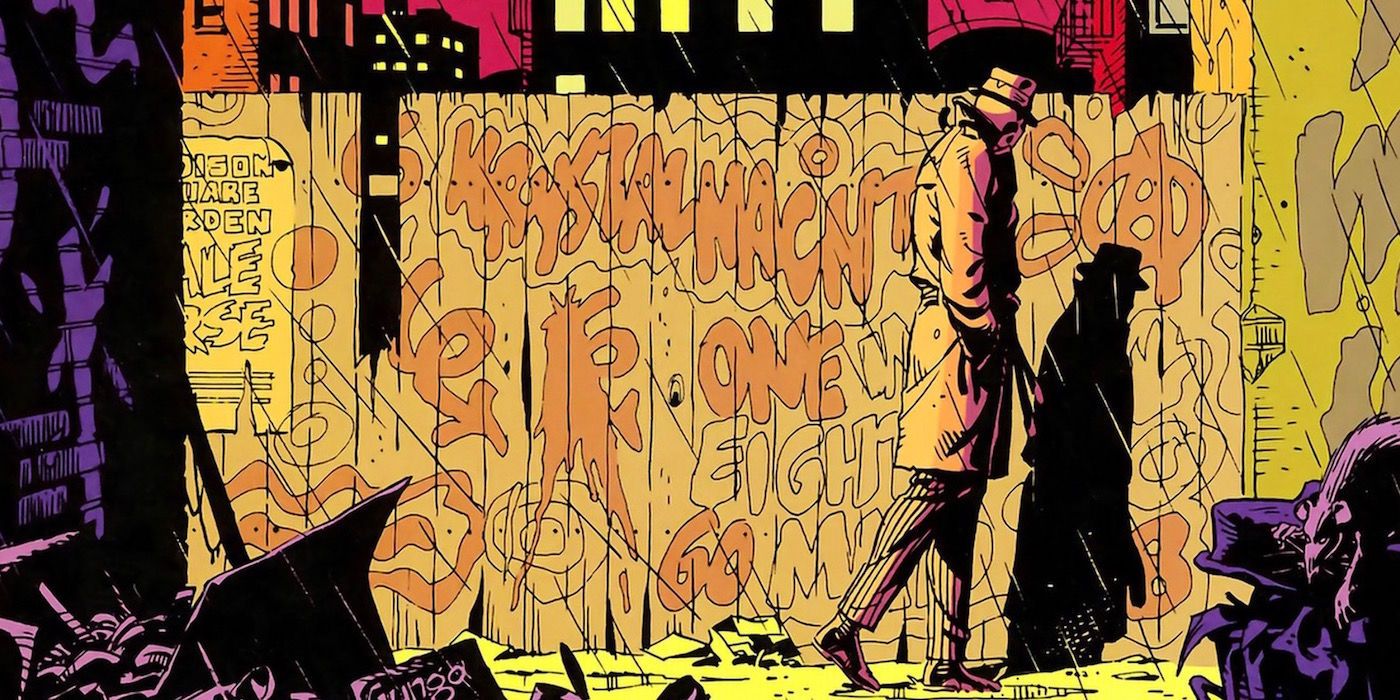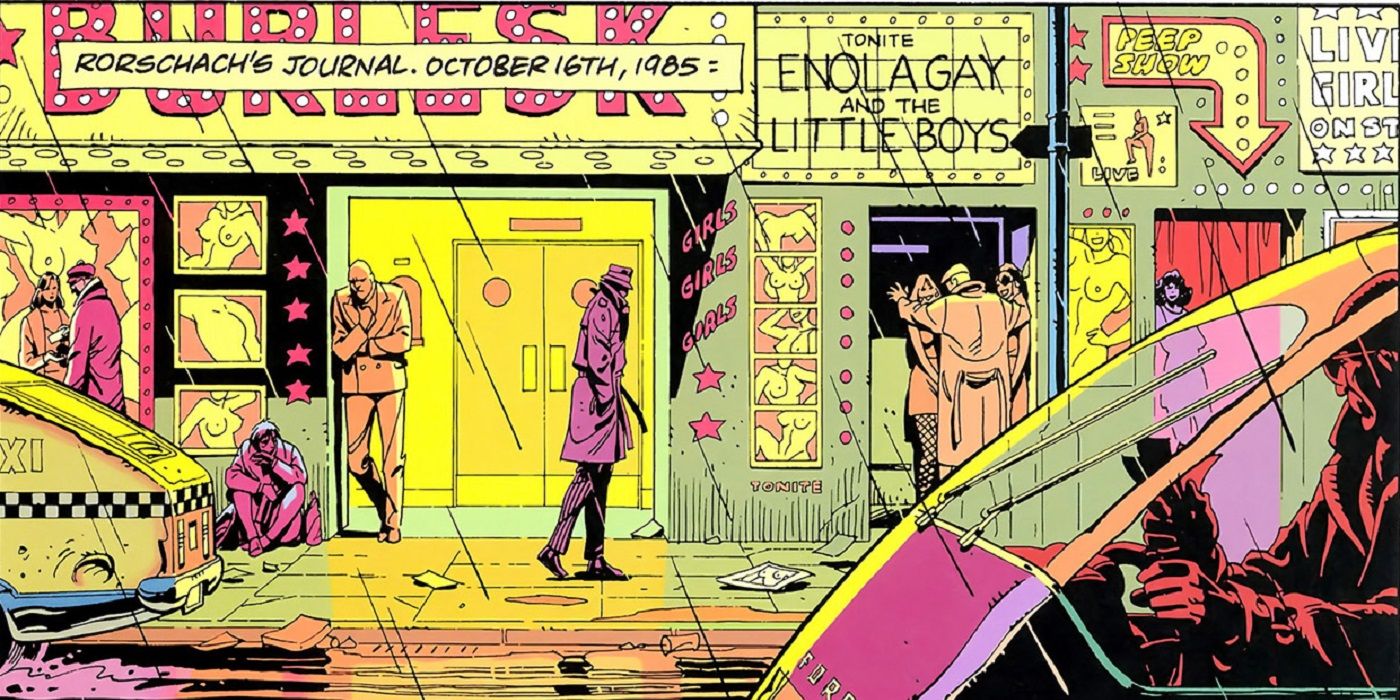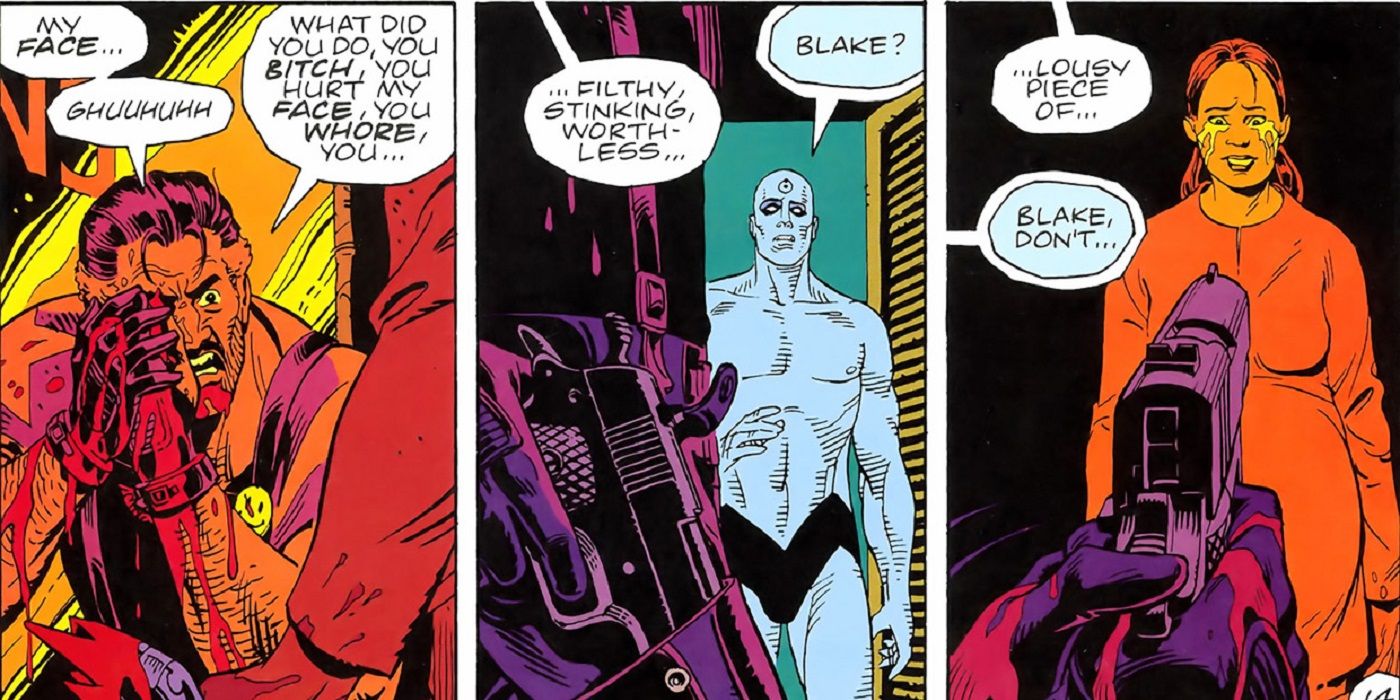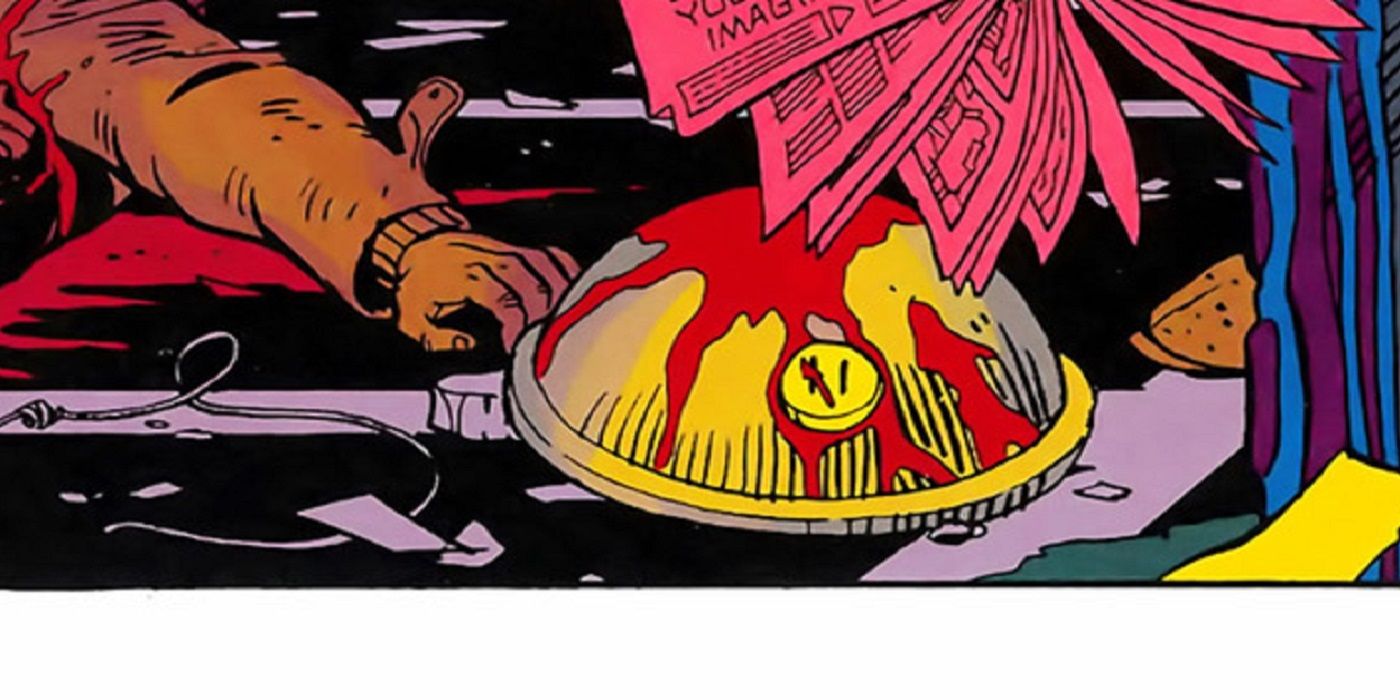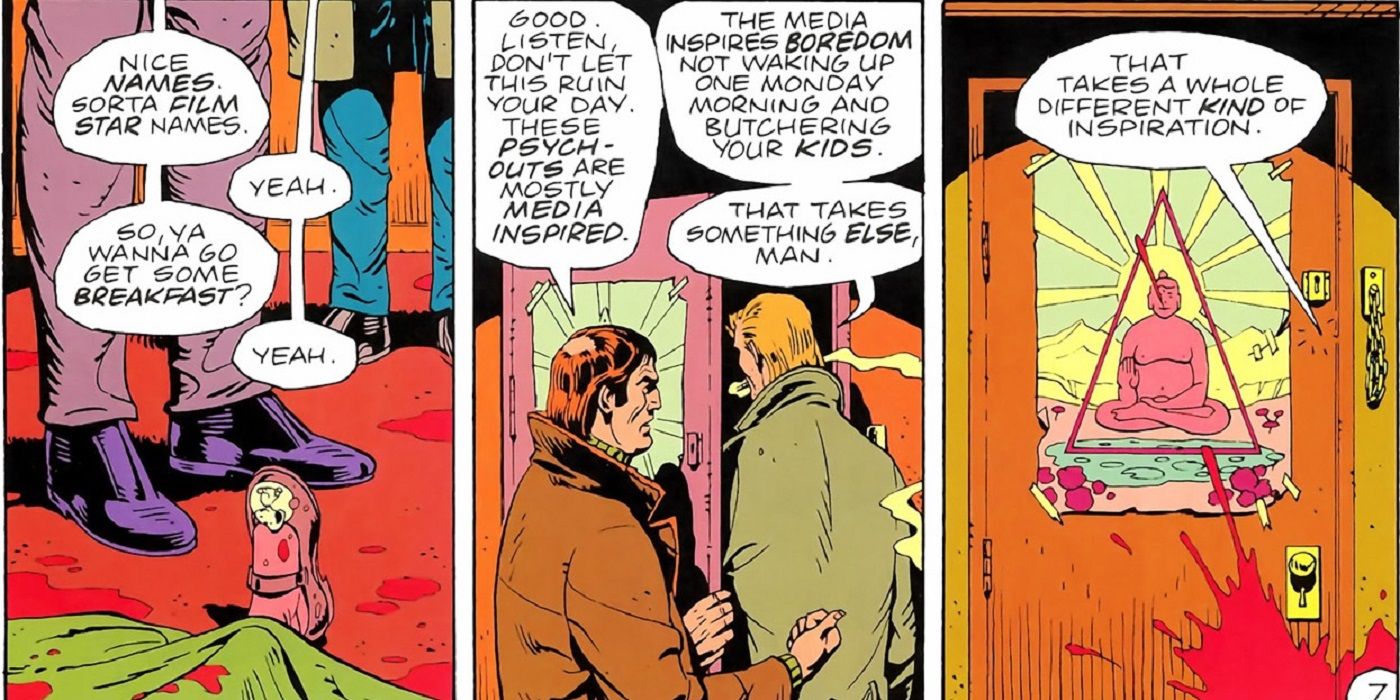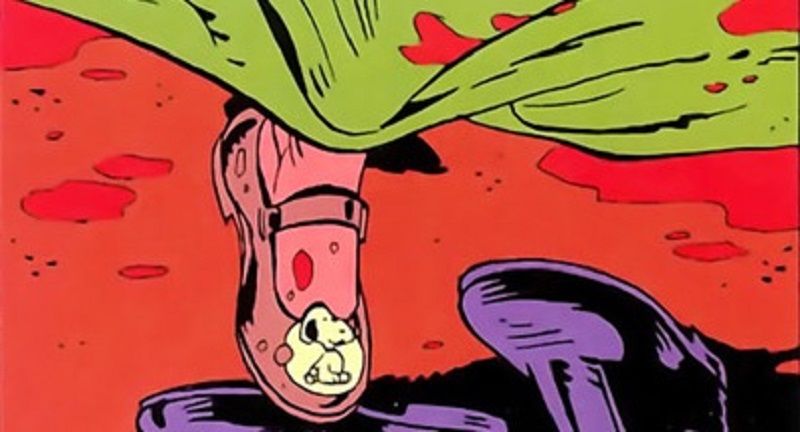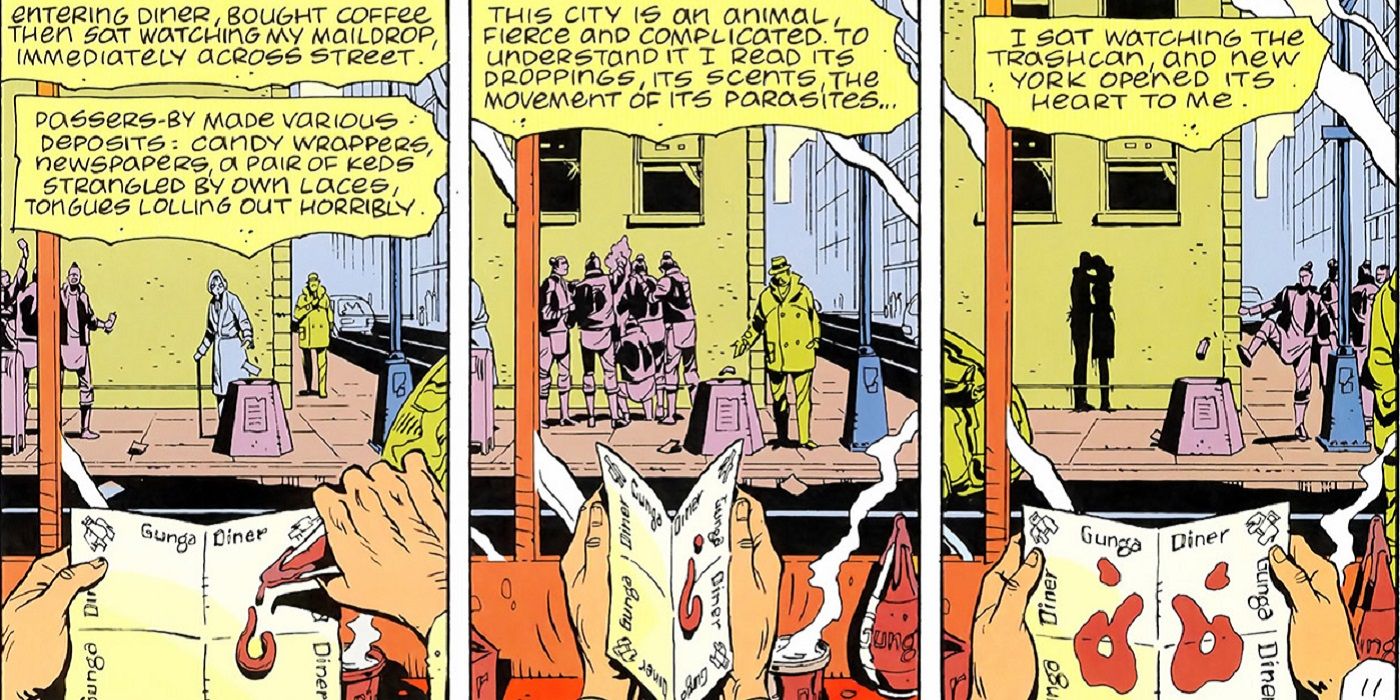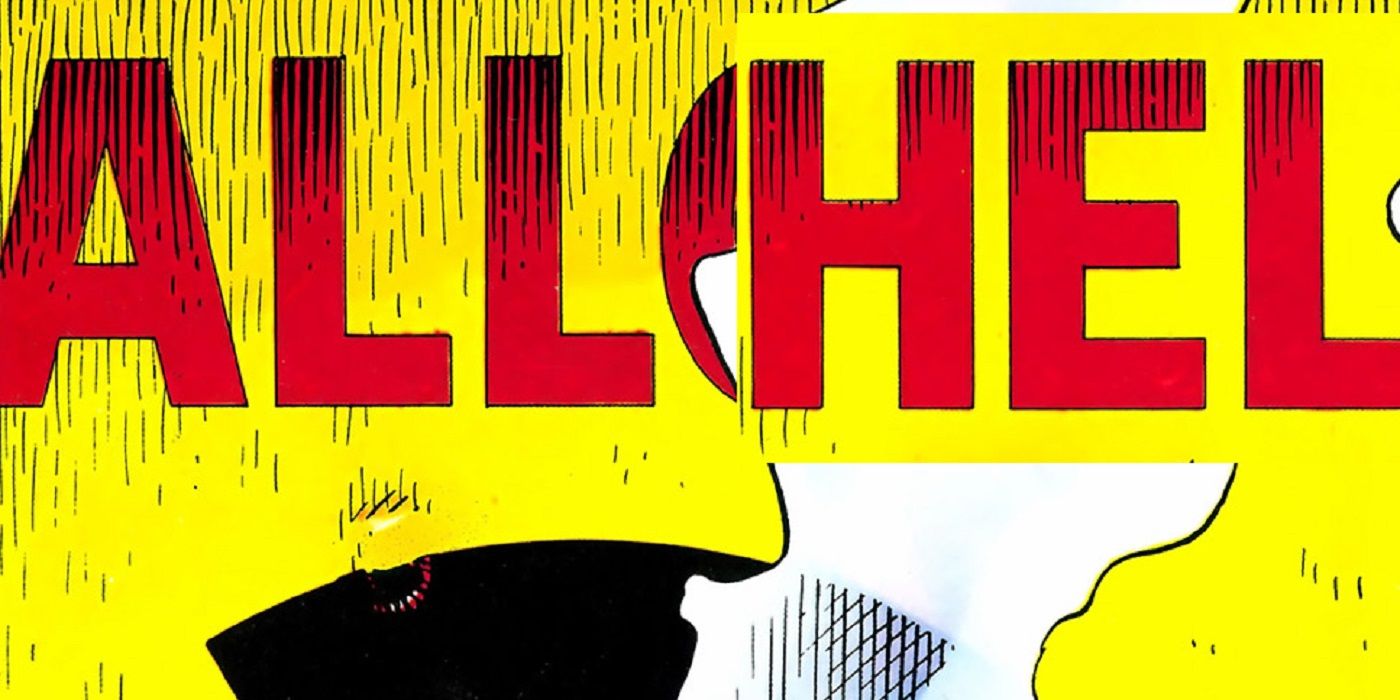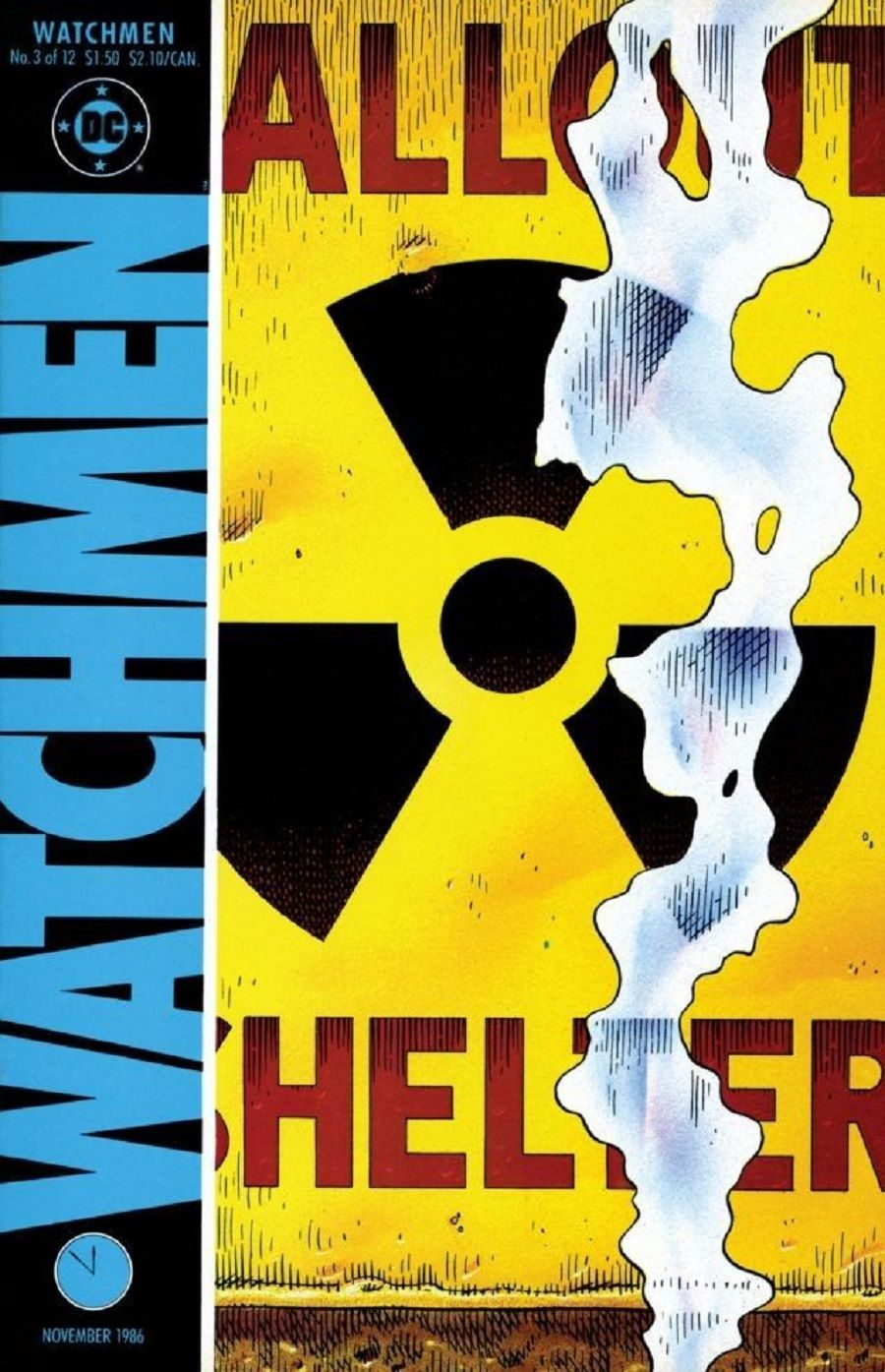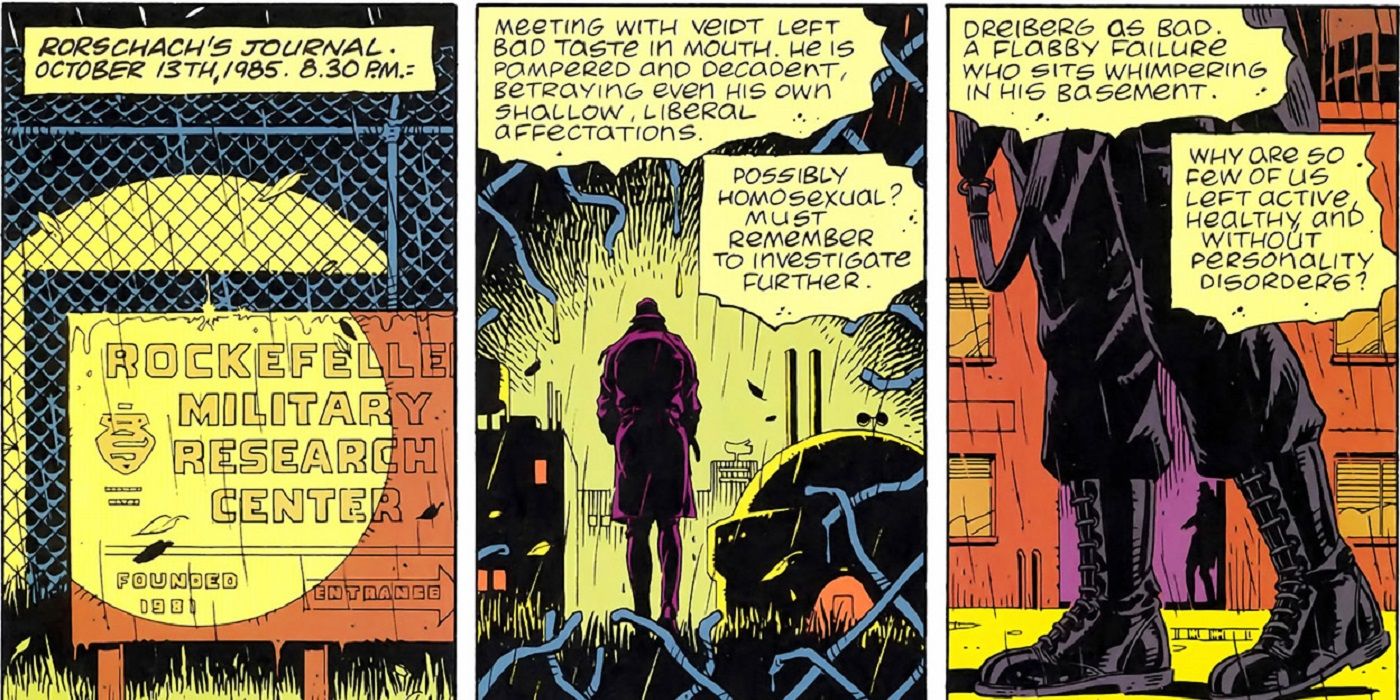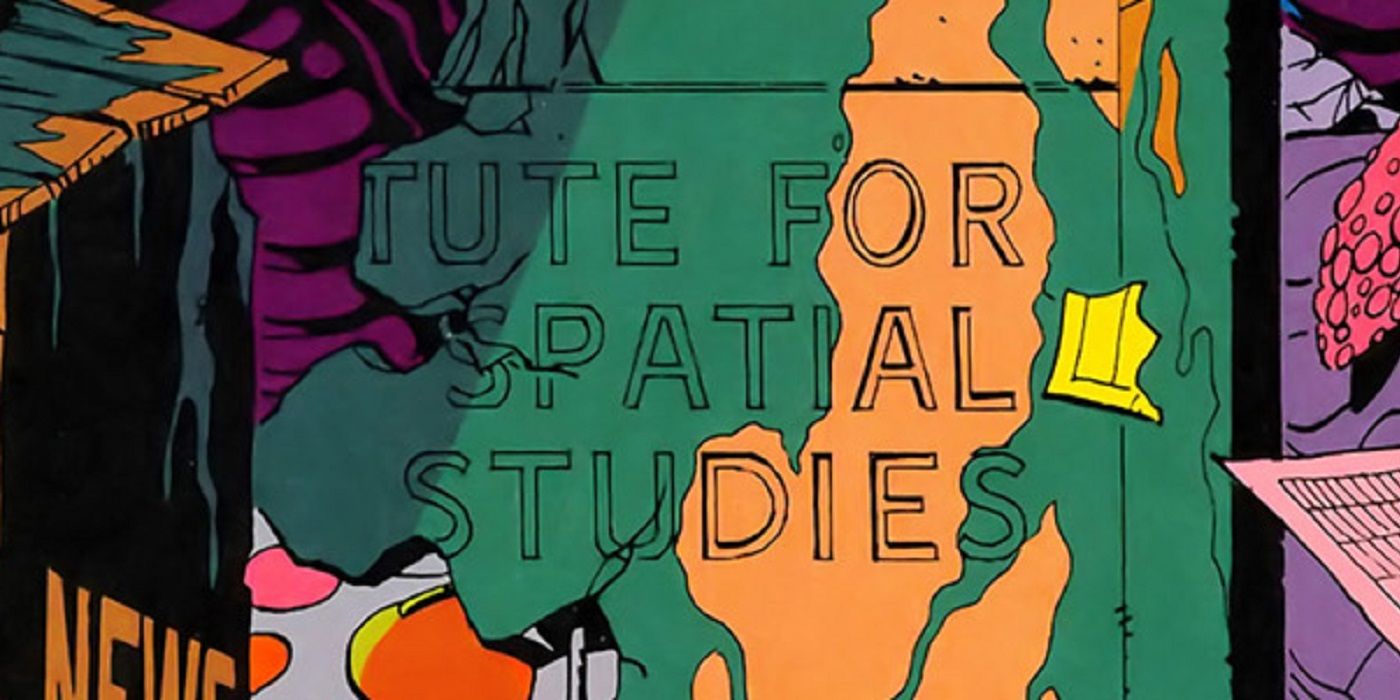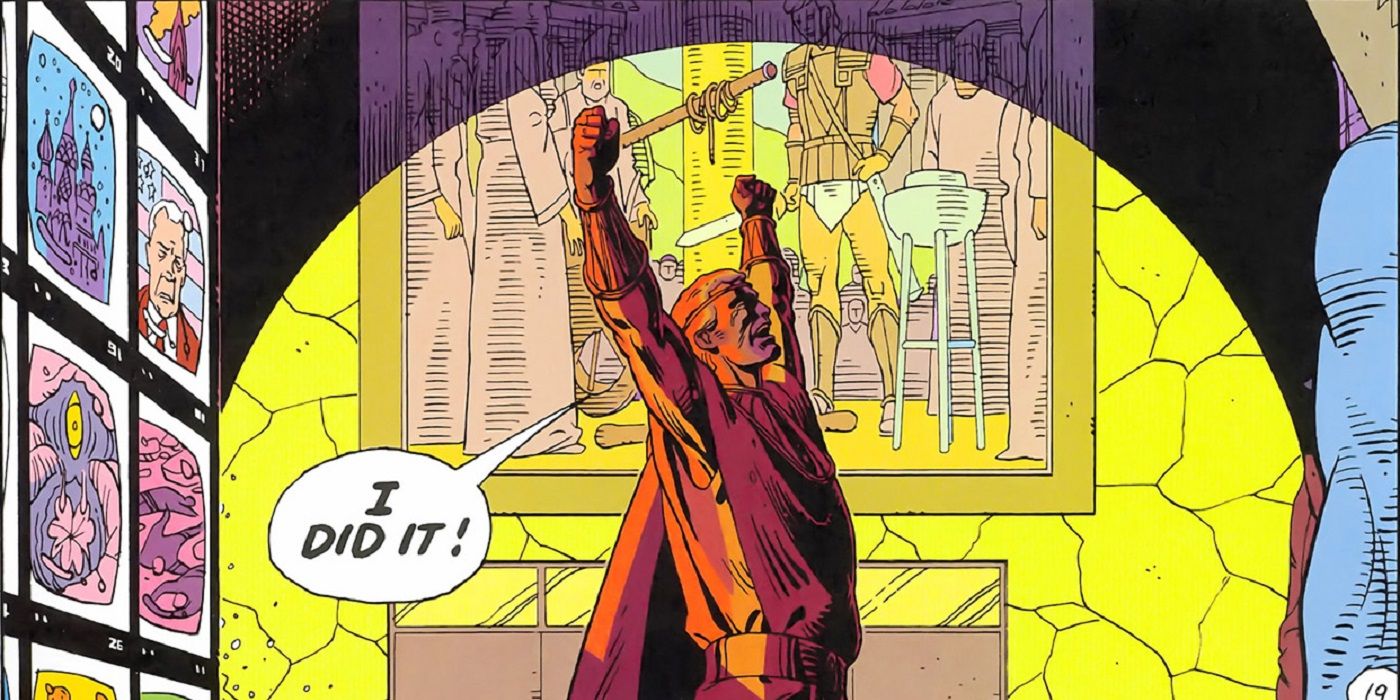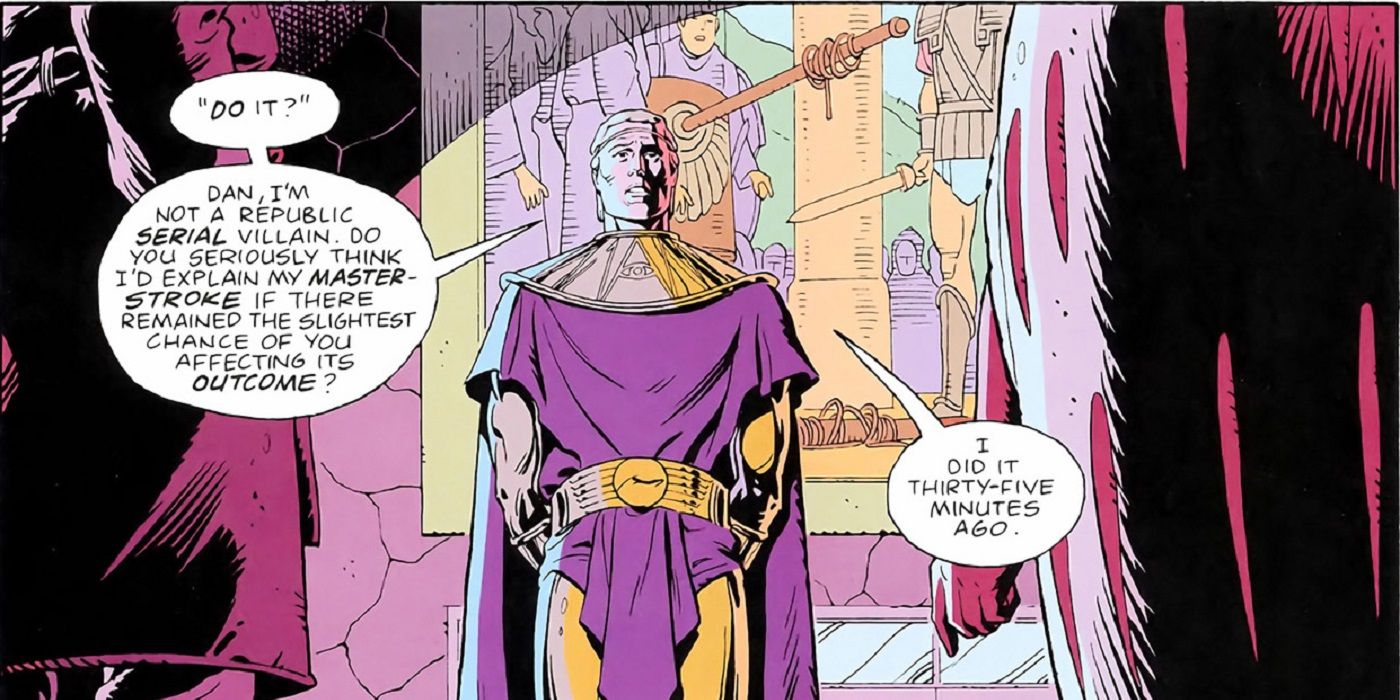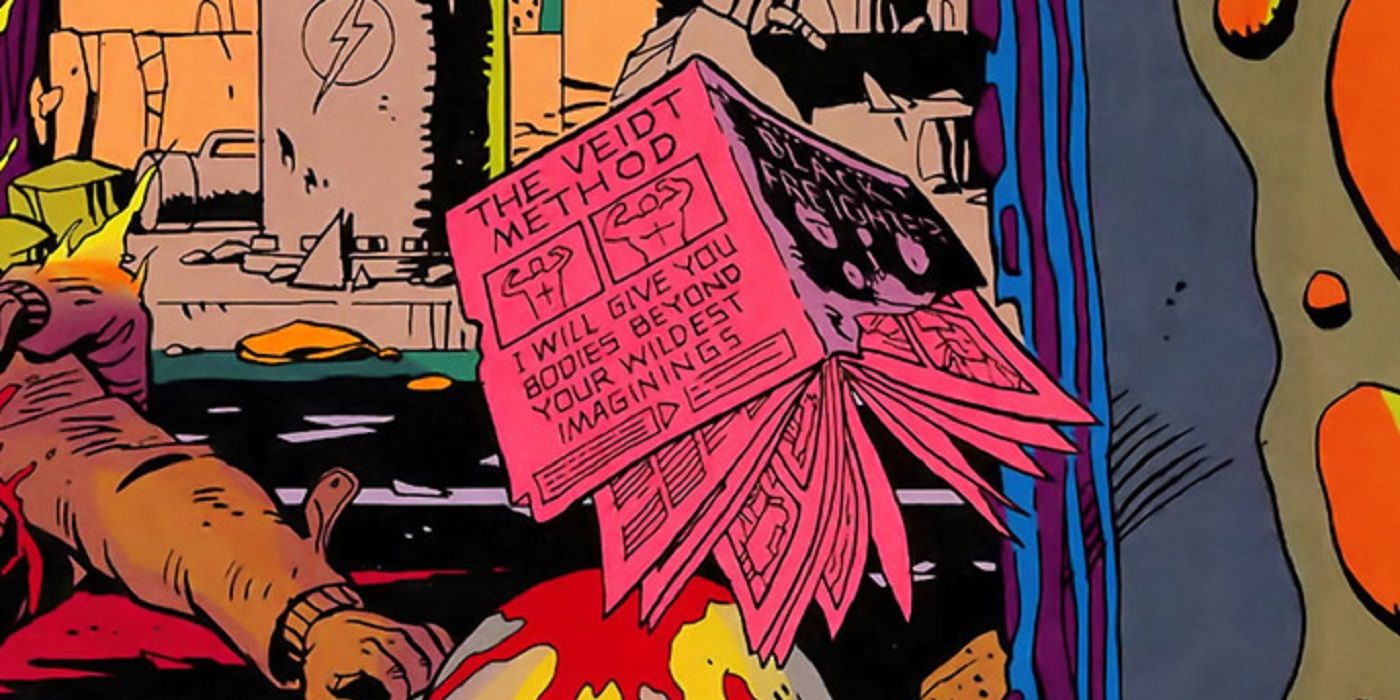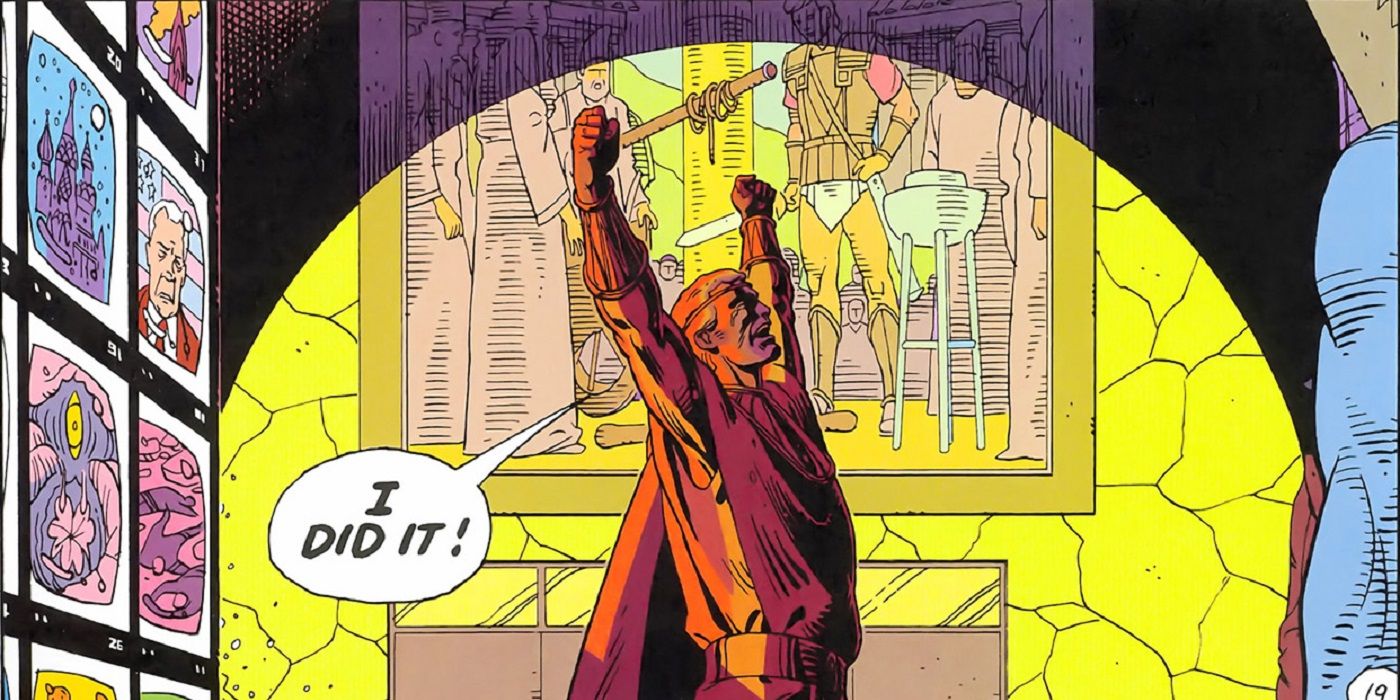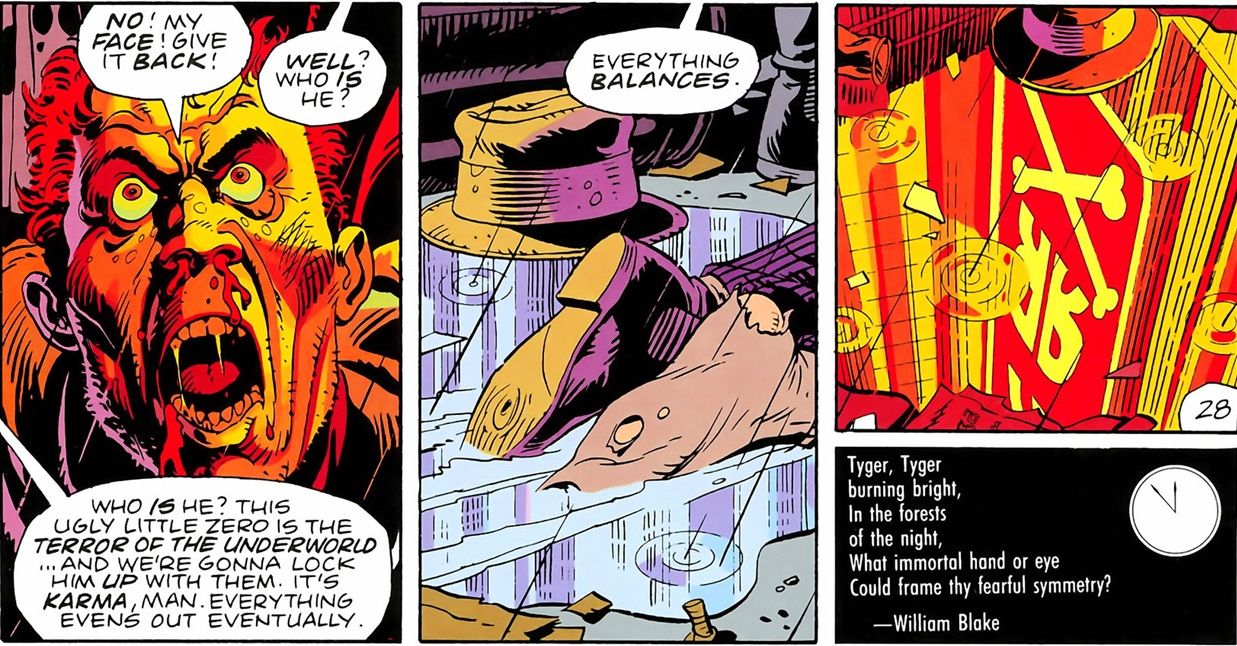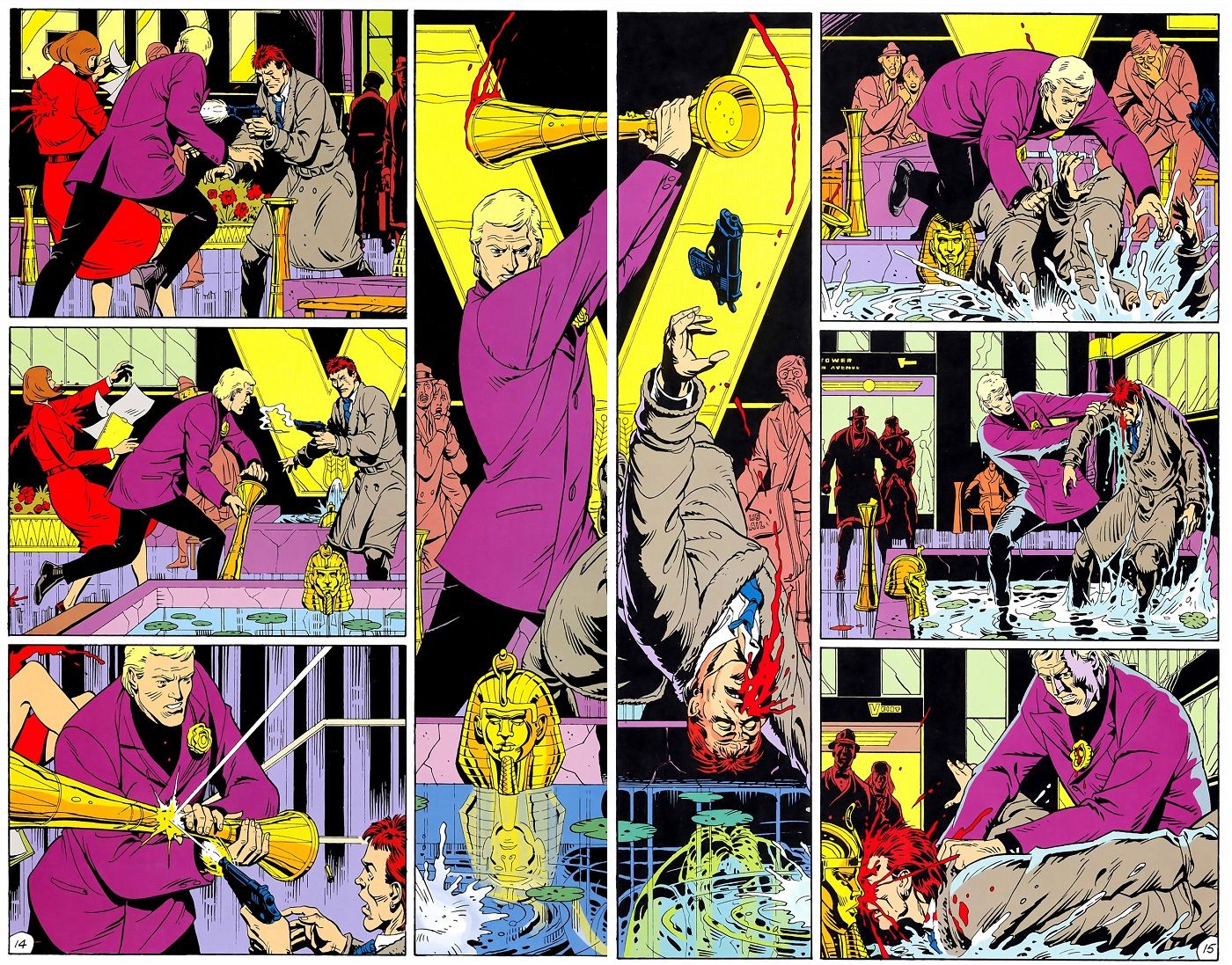Alan Moore and Dave Gibbons' comic book masterpiece, "Watchmen," is one of the most densely written comic book series ever. The level of detail that Moore and Gibbons devoted to every panel is astounding. Due to this amazing level of detail, there are plenty of small references that even an astute reader would miss on their first read of the book. These hidden gems come in the form of references, bits of subtle foreshadowing and even easter eggs, there for the reader to find on subsequent readings of the text.
RELATED: The 15 Best Doctor Strange Easter Eggs
Here, we have collected the best of these easter eggs from the original "Watchmen" comic book series (we're using the art from the "Absolute Watchmen" edition of the book because the image clarity is the best). Thanks to the WatchmenComicMovie Forum for the inspiration for a number of these! See how many you've noticed before!
WARNING: SPOILERS of "WATCHMEN" AHEAD!
15 ENOLA GAY AND THE LITTLE BOYS
The first issue of "Watchmen" debuted in 1986, when the United States and the Soviet Union were still at a tense point in the Cold War, though even by this time, there was the beginning of a "thawing" between the two; the signing of the Intermediate-Range Nuclear Forces Treaty was only a year away, for example. However, the threat of nuclear war was still very present.
Thus, the threat of nuclear war is pervasive in "Watchmen," which was set in 1985, when things were even more tense between the two countries. So, we get clever little references to nuclear war throughout the book. For instance, when Rorschach is walking through the seedy side of town in "Watchmen" #2, there is a marquee for "Enola Gay and the Little Boys," clearly some sort of burlesque show, but a reference to the B-29 bomber the Enola Gay that dropped the very first atomic bomb on Hiroshima. That bomb was nicknamed "Little Boy."
14 BLOODY BADGE #1
The most iconic symbol of "Watchmen" is clearly the bloody smiley face badge. It appears on the cover of the first issue of the series and a close-up shot of it appears on the cover of the most popular mass market trade paperback collection of the series. It is a badge that the Comedian began wearing some time in the early 1970s (after wearing a different symbol during the 1940s). The smiley face badge became such an important symbol for Comedian that he even wore it on his robe at home. He was wearing it when Ozymandias broke into his apartment and beat him badly before throwing him from his apartment window.
Throughout the series, Moore and Gibbons would cleverly evoke the bloody symbol in surprising places. We'll see a few on this list. The first one we'll look at happened in "Watchmen" #2, when we see how much of a sociopath the Comedian was during the Vietnam War. He was seeing a Vietnamese woman during the war, but when he got her pregnant, he refused to acknowledge her or his unborn child. So she slashed him in the face and the blood fell on his badge in the exact same place it would fall when he is killed by Ozymandias 14 years later.
13 BLOODY BADGE #2
One of the areas where "Watchmen" differed the most from the real world is in the technology present in "Watchmen" that came about due to the fact that the world "Watchmen" obviously had an actual super-powerful being in it. Doctor Manhattan changed a lot of things in the world. One of the areas where he had a great impact was that he used his powers to synthesize the necessary elements and chemicals to create electric-powered cars for the masses. Adrian Veidt, Ozymandias, quickly capitalized on Doctor Manhattan's newly introduced power system by patenting "spark hydrants," essentially powering stations for cars.
The spark hydrants appear throughout the book, as Bernie (the young comic book reader who is reading comics throughout the series) warms himself by sitting on one of them. In "Watchmen" #12, when the "alien" attack on Earth wiped out most of New York City, the top of the spark hydrant is knocked off and its sockets look like the eyes on the smiley face badge, along with the blood in the same place as it is on Comedian's badge (with the curved edge of the socket mimicking the smile of the badge).
12 SNOOPY
As noted earlier, the threat of nuclear war persists throughout the series and Moore and Gibbons do an excellent job showing just how bad things are and how much it affects the mindset of everyone. As crazy as Ozymandias' plan ultimately is, you can tell that he is legitimately driven by worry of the nuclear threat. It might have made him nervous enough that he mentally snapped, but the basis for the worry is legitimate enough.
In "Watchmen" #5, we see how much the worry is affecting others, as a Buddhist became so worried that he slaughtered his two young children before slicing open his own throat (note that the blood splattered on the poster of the Buddha greatly evoked Comedian's famous bloody badge). Almost too tiny to tell, the daughter's sandals have Snoopy on them, from Charles Schulz's classic comic strip, "Peanuts." Here is a detail of the sandal, flipped for easier viewing...
11 QUESTION BECOMES RORSCHACH
As you may or may not know, the story that eventually became "Watchmen" originated in a much different form by Alan Moore. The idea was generally "just" an elaborate murder mystery involving a superhero being killed and all of his colleagues being suspects. Moore believed that for the story to have the most power, the characters should be ones that people were already familiar with. He initially formalized the idea with Archie Comics' superheroes (The Shield, the Fly, etc.), but the idea didn't get past "What if Captain Strong showed up dead?"
Later, he decided to pursue the idea again, only this time using the Charlton Comics characters that DC Comics had recently purchased. This set-up was a lot more formalized. However, DC wouldn't let him use their new characters, mostly because "Watchmen" would not have put them back into nice, easy-to-use places). So, Moore developed new characters based very, very generally on mostly the Charlton characters. Obviously, though, Doctor Manhattan went places Moore would never have gone had he used Captain Atom. Same with Rorschach instead of the Question and Nite Owl instead of Blue Beetle. However, in "Watchmen" #5, Moore and Gibbons do a clever nod to Rorschach's origin by having him form his famed Rorschach symbol using a question mark to start.
10 WHAT BECAME OF VIETNAM?
Besides technological advances, a significant area where Doctor Manhattan changed the "Watchmen" universe was by being the driving force of the United States military. He pretty much single-handedly made sure that the United States won the Vietnam War. He also served as a solo nuclear deterrent; if the Soviet Union ever launched bombs on the United States, he could stop a good chunk of them and then annihilate most of Russia by himself. This allowed the United States and the Soviet Union to maintain an uneasy detente, while intensifying nuclear activities all over the rest of the world (to answer Doctor Manhattan).
In "Watchmen" #2, we see what has happened to Vietnam since the war ended. As it turned out, Vietnam became part of the United States! Forgetting the logistics of adding Vietnam as a state, this is a clever example of showing how different this world is than ours (another notable one is how Heinz has 58 varieties in this universe, rather than our 57).
9 ALL HEL
A recurring approach that Moore and Gibbons do throughout the series is to use smoke and other items to obscure letters in words so that the remaining letters spell something different. There is a notable panel in "Watchmen" #12 where a concert marquee is obscured to now read "inert." The first notable example of this approach, though, was on the cover of "Watchmen" #3, where we see a Fallout Shelter sign, only the F is intentionally cropped, so that it initially reads "Allout Helter." Helter means "undue haste, confusion, disorder," which surely describes the world of "Watchmen" at this point in the story, as unease grows over nuclear fears.
However, the smoke then gives a secondary meaning to the cover, as "Allout Helter" becomes "All Hel" after the smoke obscures the other letters, showing the end result from the undue haste towards nuclear war (this is also a reference to the title of the issue, which is a reference to Genesis, "The Judge of All the Earth." Nuclear war turns "all the Earth" into "All Hel."
8 SUPERMAN?
As noted before, the only true superhuman being in the "Watchmen" universe is Doctor Manhattan. Ozymandias does seem to possess some almost-superhuman abilities, but presumably they're just meant to show him being at the peak of physical prowess. All the others either just use brains, brawn or weaponry to fight crime -- only Manhattan actually uses super powers. The United States obviously is grateful to be the only world super power with an actual super-powered asset, so they treat Manhattan well. He is housed at Rockefeller Military Research Center, where he worked on new technology and lived with Laurie Juspeczyk.
As an acknowledgement of Doctor Manhattan's unique situation as the first superhero on this world, the logo for the Roosevelt Military Research Center (as first shown in "Watchmen" #2) is the logo of the first superhero period, Superman. It is displayed in an atomic bomb, which is in keeping with the recurring nuclear war symbols throughout the book.
7 OR ALL DIE
As mentioned in the "All Hel" entry, Moore and Gibbons would often use obscured words to form new words and phrases. This was clear in "Watchmen" #12. A building that was shown very often throughout "Watchmen" in the Institute for Extraspatial Studies. Extra-spatial dimension theory is part of superstring theory where there must be a bunch of dimensions around us that are very, very small. At the end of "Watchmen," Doctor Manhattan clearly embraced the idea of multiple dimensions.
In any event, after the "alien attack" on New York City, the name of the Institute of Extraspatial Studies is obscured so that only "Or Al Die" are visible. However, rather than having another partial word like they did with "All Hel," here Gibbons goes the extra mile and brilliantly has another piece of debris form the second "L" in "all." So it now reads "Or All Die," which follows the dark subject matter of the end of the series well.
6 CRUCIFY MY LOVE
In "Watchmen" #11, during the famous "I did it thirty-five minutes" ago speech, we see a painting behind Ozymandias...
The painting is of Alexander the Great (Ozymandias' idol) cutting the Gordian knot. The Gordian knot is a legend about Alexander that celebrates "thinking outside the box." There was a famed knot in Gordium that no one could unravel. It was a test for many. Alexander, however, solved the knot by simply cutting through it with a sword. He was celebrated for taking a different look to solving a problem. This is obviously how Ozymandias viewed his attempt to unify the world, by faking an alien attack on the planet.
However, going further, Ozymandias also saw himself as a martyr, sacrificing everything for the good of the world. Moore and Gibbons brilliantly displayed this aspect of Ozymandias' personality by showing him celebrate his "victory" by putting his hands in such a position where, combined with the painting in the background, it appears as though Ozymandias is being crucified, with Alexander's sword and the wooden pole standing in as nails through his hands/wrists.
5 WHAT THE VEIDT METHOD CAN DO FOR YOU
Firstly, yes, that does look like a Flash symbol to the upper left there. But that's not the Easter Egg we're here to discuss. One of the famous parts of "Watchmen" is the back material of each issue. Each chapter had newspaper articles or snippets from books. These pieces of information greatly inform our understanding of the world of "Watchmen." Among the things that we learned from extra material is just how Ozymandias became such a dominant figure in American society.
In his non-superhero identity as Adrian Veidt, he became extremely wealthy for his spark hydrant technology, but he also makes a lot of money selling himself, specifically "The Veidt Method," a magazine explaining how to improve yourself mentally and physically. In an extremely clever reference, after the Ozymandias' "alien attack" killed millions in New York City, we see an ad for the "Veidt Method" on the back cover of a comic book. The slogan is "I will give you bodies beyond your wildest imagining." That, of course, is exactly what Veidt did, just in a much bloodier way that anyone would have imagined.
4 BY THE POWER OF SMOKE SKULL!
The bleakness of the "Watchmen" world is also made evident on the cover of "Watchmen" #3 in an area beyond just the "All Hel" phrase.
If you look on the left side of the cover, Gibbons has used the smoke to form not only a skull, but a skull that appears to be screaming, just for extra effect. Smoking, by the way, is done differently in the "Watchmen" universe, likely intended as yet another little reminder of the ways that this universe is different from our own. People in general seem to smoke using interesting looking pipes that almost resemble crack pipes. This could be part of a response to Doctor Manhattan's futuristic technology or perhaps it is just a weird little quirk of this universe. Or maybe "Watchmen" predicted Vaping way before it was an actual thing? There's a great bit later in the series where Laurie considers quitting smoking because it is a dangerous habit. This is contrasted with the fact that the world faces nuclear annihilation.
3 BLOODY BADGE #3
As we have pointed out, throughout the book, there are many hidden bloody smiley face badges. One that we did not mention is when Ozymandias is attacked, there is blood on the yellow flower in his lapel in the same place as the blood on the smiley face badge.
However, the craziest hidden bloody smiley face badge happened in "Watchmen" #12, following Rorschach's murder at the hands of Doctor Manhattan (after Rorschach refused to go along with the cover-up of Ozymandias' "alien attack"). Throughout the last two issues, we continually see the tunnel entrance to Ozymandias' antarctic retreat. The tunnel is yellow. After Rorschach is killed, the explosion of his body sends some red mist into the air. The red mist passed by the entrance of the tunnel right in the same place as the blood on the bloody smiley face badge. An icicle forming on the entrance of the tunnel forms one of the eyes on the badge. Rorschach's speeder forms the other eye. And the lines of the tunnel forms a cracked version of the smile. What an amazing piece of detailed work by Moore and Gibbons.
2 OZYMANDIAS FORMS A CLOCK
Another iconic piece of imagery used throughout "Watchmen" is the "Doomsday Clock," which is actually a real thing. It is a symbolic clock maintained by The Bulletin of the Atomic Scientists' Science and Security Board that gets moved closer or further away from midnight the closer or further away the world is from nuclear destruction. Nowadays, climate change also factors in to how close the clock gets to midnight. At the time "Watchmen" was released, the clock was just three minutes away from midnight, a mere minute away from the closest the clock has ever come to midnight. It hit two minutes in 1953. After getting as far away as 17 minutes from midnight in 1991, it returned to three minutes away in 2015.
Throughout the series, the clock gets closer and closer to midnight. Here are the final panels of "Watchmen" #5 and #6. Look at how the clock moves...
In the end, though, Ozymandias' "alien attack" has unified the world, so he has succeeded in stopping the clock before it hit midnight. After he enacts his plan, though, see that Ozymandias' successful glee is reflected with him forming a clock himself. Also note that the clock is still very close to midnight, suggesting that rather than truly succeeding, Ozymandias merely reset the clock. It will keep ticking towards midnight.
1 FEARFUL SYMMETRY
The greatest easter egg in "Watchmen" is literally an entire issue long. "Watchmen" #5 is named "Fearful Symmetry" after a line from William Blake's "The Tyger." However, just as the cover shows the symmetrical Rs, the issue itself is entirely symmetrical. That is to say, the first page is a reflection of the last page, the second page is a reflection of the second to last page and so on and so forth, until the book meets in the middle, which is a double page spread with a V in the middle....
See how the panels on each page mirror each other? That goes on throughout the comic! So, if, say, Laurie is in the foreground of a panel and Dan is in the background, then later in the comic, their mirrored panel will have Dan in the foreground and Laurie in the background. You could spend hours just examining the almost insane level of detail that Moore and Gibbons put into making the issue match throughout the book. Admittedly, some panels match better than others, but it is incredible what the team here managed to accomplish. "Watchmen" is truly one of the most remarkable pieces of comic book work ever.
Can you think of some good "Watchmen" Easter Eggs that we missed? Let us know in the comments section!

